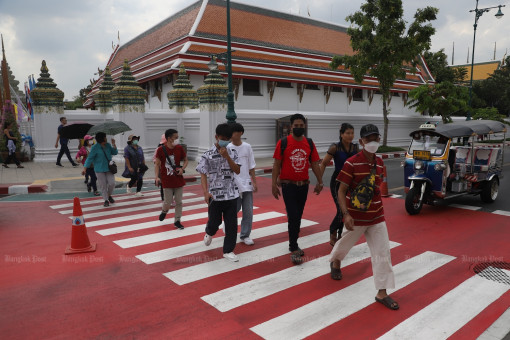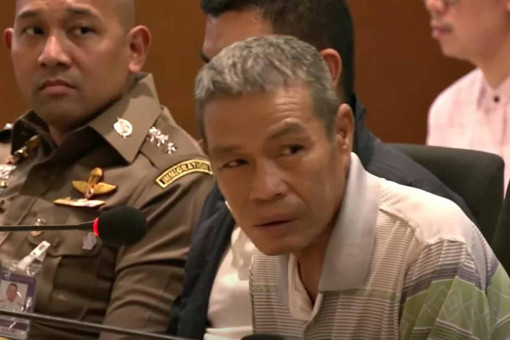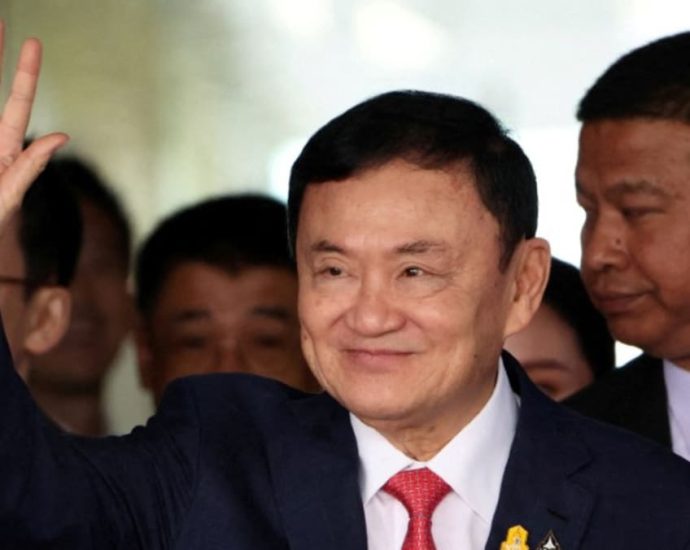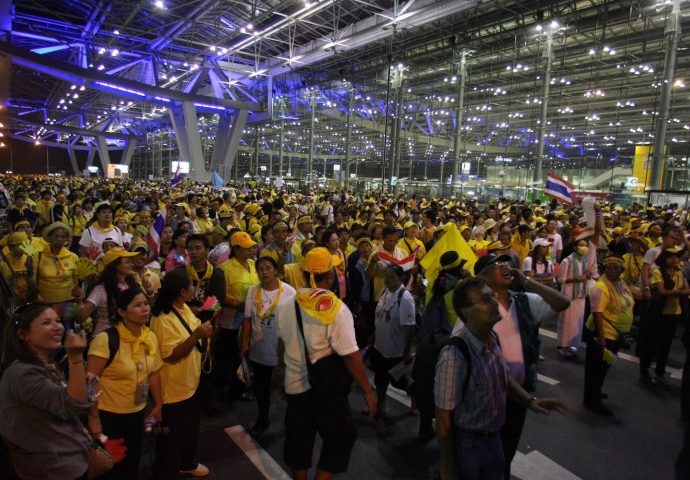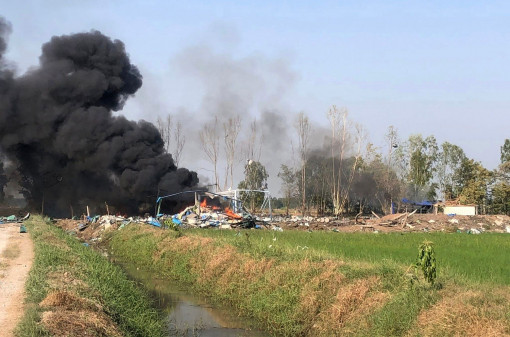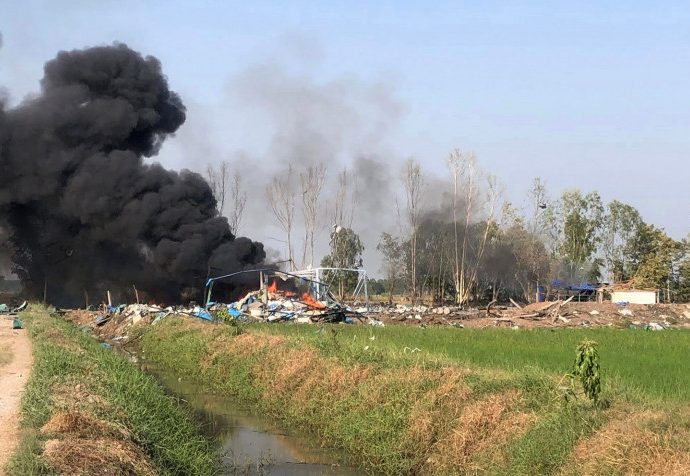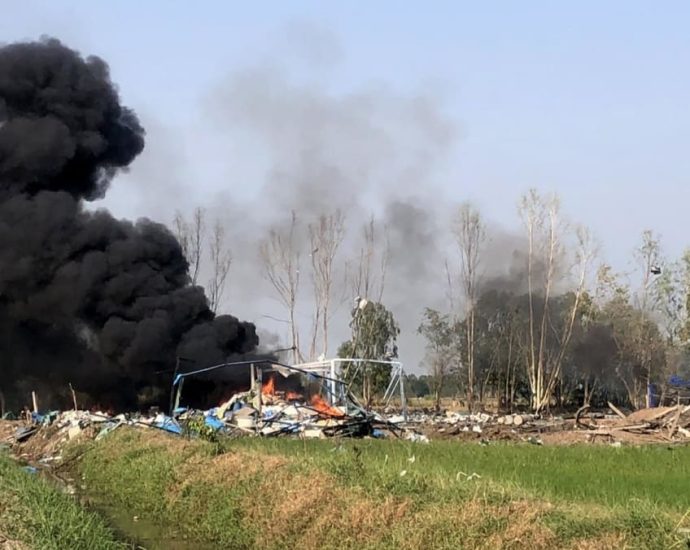Smoking pot âmay require doctorâs noteâ
Health minister Cholnan says new bill will be clear on medical uses of cannabis

Smoking cannabis is likely to require a permit from a doctor, according to Public Health Minister Cholnan Srikaew, who says his new cannabis bill differs from a failed predecessor as it will be very clear on how to use the plant for medical treatment.
Dr Cholnan insisted that the bill preserves a key point that cannabis is to be used for medical treatment only, and any use for recreational purposes will not be allowed.
Consequently, he said, it is very important to make clear precisely how to use cannabis for medical purposes. The bill clearly stats who can use cannabis, where and when it can be sold, and methods for selling it, depending on the part of the plant used and concentrations of CBD or THC. The former is used in many medical applications and does not make a person “high”, whereas THC does.
The minister said the process of drafting the bill was being based on participation from all stakeholders, and he welcomed suggestions from anyone concerned about people’s health.
Any cannabis plantation will require a permit from authorities and must adopt advanced agricultural practices to ensure the plants will be medical-grade. Any plantations at home are not likely to continue.
When the Bhumjaithai Party pushed for liberalisation of cannabis, one of its selling points was that thousands of families could make money by growing cannabis.
In the draft bill proposed last year by Bhumjaithai but never passed by the House, cannabis smoking is allowed in a private space if it is for medical treatment. But in the current version, such references have been omitted.
“If smoking is for health, we need to have a clear prescription from the doctor,” said Dr Cholnan, a physician and former hospital director from Nan.
The Ministry of Public Health has been gathering public opinion online and elsewhere on its new cannabis draft.
Civil society groups led by Prasittichai Nunual, secretary-general of the Thai Cannabis Future Network, believes the definition of recreation in the draft bill is still unclear and any interpretation is based on judgement calls by authorities, which is not fair for people.
The bill, he said, should add a clause giving the right to people to use cannabis in the family based on traditional medicine knowledge.
He also pointed out that the bill seems to place too much emphasis on taking legal action against users who violate the law, reflecting the perception that cannabis is still regarded as a dangerous drug. In his view, penalties should be similar to those associated with cigarette or alcohol use.
“The main point is that the bill will be a compass to set the direction of cannabis in the future in the country, with a principle to preserve its use under Thai traditional medicine wisdom,” said Mr Prasittichai.
“It should not have any barriers to prevent people from planting it and the bill should prevent any benefit-taking by the authorities,” he said, adding that passing the bill is important to ensure that cannabis will not be relisted as a narcotic.
The thousands of businesses that have sprung up since cannabis was decriminalised are anxiously awaiting clarity about their futures.
An ongoing regulatory vacuum, following the delisting of marijuana as a narcotic in June 2022, has led to a proliferation of dispensaries — estimated to total 6,000 — all over the country. They sell everything from cannabis buds to oil extracts containing less than 0.2% tetrahydrocannabinol — the psychoactive compound that gives users a “high” sensation.
Stiffer sentence for policeman who ran over doctor
Appeal court says original penalty was too lenient in case that led to calls for pedestrian safety
PUBLISHED : 17 Jan 2024 at 20:38

The Court of Appeal on Wednesday increased the prison term handed to a junior policeman who ran over and killed a doctor on a pedestrian crossing in January 2022.
The sentence imposed on Pol L/Cpl Norawich Buadok was lengthened from one year and 15 days to five years and one month.
It said the original sentence handed to the officer attached to the Protection and Crowd Control Division of the Metropolitan Police Bureau, was too lenient.
The court said Pol L/Cpl Norawich failed to slow down when approaching the zebra crossing while driving an unregistered and uninsured vehicle with no licence plate.
Dr Waraluck Supawatjariyakul died from her injuries after being hit by a motorcycle driven by the officer at the zebra crossing on Phaya Thai Road in Ratchathewi district. The tragedy sparked calls to improve road safety for pedestrians.
Pol L/Cpl Norawich was initially sentenced to two years and 30 days in prison and fined 8,000 baht by the Criminal Court in April 2022, but the sentence and fine were cut due to his confession.
He was released on bail pending an appeal in which he asked the court to suspend the jail sentence. The prosecutor and the victim’s family asked for a tougher sentence.
The Court of Appeal initially sentenced him to 10 years for reckless driving causing death and added two months for speeding before cutting the sentence by half. The 4,000-baht fine ordered by the Criminal Court was upheld.
Pol L/Cpl Norawich submitted a bail request with a surety of 300,000 baht but the Criminal Court forwarded the request to the Supreme Court for consideration. He will be held at Bangkok Remand Prison pending the court decision, which is expected in a few days.
Police probe claim of forced murder confession
Deputy national chief in Aranyaprathet to follow up case in which policemen’s sons are implicated
PUBLISHED : 17 Jan 2024 at 20:09

Police are trying to confirm whether a man in Aranyaprathet was forced by a group of men to confess to killing his wife, although it was found later that she had died after being assaulted by a group of teenage boys, two of them sons of policemen.
Deputy national police chief Pol Gen Surachate Hakparn said on Wednesday that he had been made aware of a video and witnesses’ accounts indicating that a group of men covered the head of Panya Khongsaenkham with a black bag, chained and assaulted him and forced him to confess to the murder of his 47-year-old wife, Buaphan Tansu, in the border town in Sa Kaeo province early last Friday.
Pol Gen Surachate said his team would verify the report. Closed-circuit TV video showed that Mr Panya, 54, disappeared for two hours after his arrest, although the location of the arrest was not far from the Aranyaprathet police station where he was first officially questioned and charged, Pol Gen Surachate said.
If Mr Panya was forced to make the confession, he would be re-interrogated. If he was forced to confess by policemen, they would face both criminal and disciplinary action, the deputy national chief said.
Pol Gen Surachate travelled to Aranyaprathet to meet Mr Panya and look into the police handling of the investigation into Buaphan’s death.
He said he had informed national police chief Pol Gen Torsak Sukvimol of the new development in the case. He also promised there would not be any favour for any policemen’s children.
After Buaphan was found dead, Mr Panya confessed to assault causing the death of his wife, who was reportedly mentally unstable. However, security video subsequently showed the woman being harassed by a group of five teenage boys aged 13-16 years near a convenience store in the early hours of last Friday.
She threw a bottle at them. The group then assaulted her and took her on one of their motorcycles. Her body was found later on Friday in a pond. Two of the young assailants were reportedly local policemen’s sons.
The five boys already confessed to the crime and Mr Panya appeared to have been made a scapegoat earlier, said prominent activist Kanthat Pongpaiboonvej, alias the “good Samaritan” Kan Chompalang.
Study finds joint and muscle pain top menopausal symptom for women in Singapore

MORE RESEARCH IN THE WORKS
Prof Yong said the findings underscore the necessity of conducting such studies locally to understand and manage the symptoms experienced by Singaporean women.
Despite such pains being common complaints from women experiencing menopause, little research has been done on the cause and risk factors associated with the condition.
“Menopausal arthralgia is a condition that even clinicians globally are not well aware of,” he said. “Filling these gaps will help understand the burden of arthralgia and its associated factors … and may shed understanding on improving its management.”
Menopausal joint and muscle pain have often been mistaken as an inevitable part of the ageing process.
Madam Amy Fang, a participant in the study who has endured a decade of arthralgia, said the condition has caused her excruciating discomfort, including in her spine and nerves, hindered her ability to perform basic daily tasks, and significantly affected her quality of life.
“It was first presented to me as (a symptom of ageing) and told there isn’t anything I can do. Nobody told me that it could possibly be linked with menopause. It was a very difficult journey because no one understood the pain I was going through,” she said.
She is among an increasing number of women seeking treatment at NUH for menopausal symptoms. The hospital said patients with such symptoms have significantly increased over the years due to the ageing population and greater awareness.
Prof Yong said exercises that strengthen the muscles will help to ease tension and stress on the joints.
“Joint pains are associated with weak muscles. Proper strengthening of the muscles will help to protect the joints,” he explained.
Studies are also in the works to develop targeted interventions, he said. They include exercise regimes to enhance muscle strength and exploring menopausal hormone therapy’s potential in alleviating pain.
“We are planning a study to see whether hormones and exercise, whether alone or in combination, can help the situation and hopefully help those like Mdm Fang get a better quality of life.”
Temasek-owned Accuron Technologies expands semiconductor presence with acquisition of Recif TechnologiesÂ
Solidifies growing footprint in semicon industry and presence in Europe
Positions Accuron as a versatile and innovative provider in chip industry
Accuron Technologies, a 1981 founded Temasek owned global precision engineering and technology group based in Singapore, announced its acquisition of Recif Technologies, a France-based company specialising in the design, manufacture, and installation…Continue Reading
Jailed former Thai prime minister Thaksin qualifies for parole next month
Thaksin was ousted from power in a 2006 military coup and has been at the heart of 17 years of on-off turmoil in Thailand, influencing politics from exile. Thaksin, a former telecoms tycoon and owner of Premier League football club Manchester City, was accused by the military of corruption, cronyismContinue Reading
2008 airport protesters cleared of insurrection
13 yellow-shirt activists fined B20,000 each for causing disruption
PUBLISHED : 17 Jan 2024 at 18:45
UPDATED : 17 Jan 2024 at 19:07

The Criminal Court on Wednesday dismissed insurrection charges against 32 yellow-shirt activists who led an anti-government protest that shut down Bangkok’s two main international airports in 2008.
Thirteen out of 32 leading members of the People’s Alliance for Democracy (PAD) will still have to pay a fine of 20,000 baht each for the disruption that closed Don Mueang and Suvarnabhumi airports.
The seizure of the airports was estimated to have cost the Thai economy at least 3 billion baht a day in lost shipment value and other opportunities.
“This case will set a precedent for those who love this country and want to fight for justice in the country to hold protests,” Panthep Puapongpan, one of the 32 activists, told reporters after the ruling was read.
Prosecutors can appeal the ruling.
The PAD blockaded the two airports from Nov 25 to Dec 4, 2008, disrupting hundreds of flights and leaving hundreds of thousands of travellers stranded.
The PAD was formed in 2005 in opposition to then-prime minister Thaksin Shinawatra, who was overthrown a year later in a military coup. Two years later, he fled the country to escape court cases against him. He returned in August last year.
The PAD protesters in 2008 were attempting to force the resignation of leaders of the Somchai Wongsawat government, who were accused of being puppets of Thaksin.
While the airports were still closed by the yellow-shirt protest, the Constitutional Court on Dec 2 dissolved the three parties of the Somchai government coalition.
The court ruled there was insufficient evidence to prove the defendants had committed insurrection, assaulted officials or obstructed them from performing their duties, or illegally detained any official or disrupted a communications system or air travel services during their protest at the airport.
The protest was also peaceful and the protesters were unarmed, resulting in the acquittals.
Nevertheless, the court ordered 13 defendants to pay a fine of 20,000 baht each for trespassing and violating the emergency decree in force at the time.
They included Maj Gen Chamlong Srimuang, Sondhi Limthongkul, Pibhop Dhongchai, Somsak Kosaisuk, Suriyasai Katasila, Sirichai Mai-ngam and Samran Rodphet.
In a civil case in 2017, the Supreme Court ordered 13 PAD leaders to pay a total of 522 million baht to Airports of Thailand Plc for shutting down the two airports in 2008. The case was closed after the activists were declared bankrupt.
At least 22 killed in Suphan Buri fireworks explosion
Blast was second fatal incident at factory in Muang district

At least 22 people were killed on Wednesday in an explosion at a Suphan Buri fireworks factory where a blast a year ago left one person dead and three injured. About 10 more people are said to be missing.
The explosion occurred at village Moo 3 in tambon Salakhao of Muang district around 3.30pm. So far, 20 of the dead have been identified.
The force of the blast spread debris in a radius of 100 metres, with human remains scattered everywhere.
Local residents said that about 20 workers had arrived to work at the factory in the morning and that they saw nobody come out after the explosion.
“We cannot tell whether all the workers were killed. The officials are entering the site to investigate. They have not found any survivors,” provincial governor Nattapat Suwanprateep told Reuters earlier.
The factory owner was not among the dead because he had gone out to deliver fireworks to customers at the time, said Thongsuk Suenui, deputy chairman of tambon Salakhao municipality. (Story continues below)

Rescue workers inspect the scene of the explosion. (Photo: Ministry of Interior)
The factory was operating out of a farmhouse which where gunpowder and other raw materials for fireworks were stored. The operator had reportedly sought permission from the relevant agencies and a public hearing was held.
There were reports that an explosion at the same factory in November 2022 killed one person.
Authorities are investigating the cause of the blast.
Prime Minister Srettha Thavisin was briefed on the explosion while at the World Economic Forum in Davos, Switzerland and urged a swift investigation.
“The prime minister ordered an inspection of the plant to see if it was operating legally and if the explosion was caused by negligence. The law must be enforced to the fullest extent because there are innocent deaths and injuries,” his office said.
Local officials said the 20 people confirmed as dead included 12 women and 8 men. They were identified as: Ms Ramphai Khenma, Sophon Soikhakhao, Ms Saengduen Prangchan, Tam Prangchan, Ms Maem Khwan-on, Ms Namphon Kerdnok, Ms Phayao Bunklom, Ms Bunklua Thongsamrit, Thaweesak Thongsamrit, Ms Ratchanee Phanton, Rungrot Ounnoi, Somnuek Bunklong, Ms Manop Juadphan-in, Ms Phorntip Phantaeng, Keng (surname not khown), Ms Tuenjai Yimyaem, Samran Saithong, Somkhuan Jaengwithee, Ms Suchada Phanphuek and Ms Phassorn Naksomphong.
History repeating
Records show there were 24 explosions at fireworks factories and warehouses over the 15 years between 2008 and 2023, with each incident causing extensive damage including many deaths and injuries.
Many illegal fireworks factories and warehouses that lack standards are located in different communities throughout Thailand, according to Sonthi Kotchawat, an environmental and health expert.
After a tragedy in July 2023 in Narathiwat in which 11 people were killed and 389 injured, Mr Sonthi said the failure by the relevant agencies to form partnerships to proactively address this problem was clear.
In order to prevent history from repeating itself, he said, they should reassess and change all the related rules and regulations as well as increase the penalties against violators.
According to Mr Sonthi, a fireworks factory or warehouse that meets the standards must include a “bubble zone” – with a fence set up at least 20 meters from its building – and have a reserved area that prevents any community expansion from getting into its 100- to 500-metre radius depending on the quantity of fireworks in the factory.
The factory building must be a one-storey stand-alone building without an underground or mezzanine floor. It must be built using inflammable materials and include a lightning rod. The roof must be able to reduce the impact of an explosion. Moreover, it must have a ventilation system that extracts heat and controls the temperature under 30 degrees Celsius and two chemical fire extinguishers for every 100 square metres.

Debris is scattered near the site of Wednesday’s explosion. (Photo: Suphan Buri Highway Rescue Association)

Officials and rescue workers arrive at the explosion site. (Photo: Ministry of Interior)
At least 20 killed in Suphan Buri fireworks explosion
Blast was second fatal incident at factory in Muang district

At least 20 people were killed on Wednesday in an explosion at a Suphan Buri fireworks factory where a blast a year ago left one person dead and three injured. Ten more people are said to be missing.
The explosion occurred at village Moo 3 in tambon Salakhao of Muang district around 3.30pm.
The force of the blast spread debris in a radius of 100 metres, with human remains scattered everywhere.
Local residents said that about 20 workers had arrived to work at the factory in the morning and that they saw nobody come out after the explosion.
“We cannot tell whether all the workers were killed. The officials are entering the site to investigate. They have not found any survivors,” provincial governor Nattapat Suwanprateep told Reuters earlier.
The factory owner was not among the dead because he had gone out to deliver fireworks to customers at the time, said Thongsuk Suenui, deputy chairman of tambon Salakhao municipality.
The factory was operating out of a farmhouse which where gunpowder and other raw materials for fireworks were stored. The operator had reportedly sought permission from the relevant agencies and a public hearing was held.
There were reports that an explosion at the same factory in November 2022 killed one person.
Authorities are investigating the cause of the blast.
Prime Minister Srettha Thavisin was briefed on the explosion while at the World Economic Forum in Davos, Switzerland and urged a swift investigation.
“The prime minister ordered an inspection of the plant to see if it was operating legally and if the explosion was caused by negligence. The law must be enforced to the fullest extent because there are innocent deaths and injuries,” his office said.
Local officials said the dead included 12 women and 8 men. They were: Ms Ramphai Khenma, Sophon Soikhakhao, Ms Saengduen Prangchan, Tam Prangchan, Ms Maem Khwan-on, Ms Namphon Kerdnok, Ms Phayao Bunklom, Ms Bunklua Thongsamrit, Thaweesak Thongsamrit, Ms Ratchanee Phanton, Rungrot Ounnoi, Somnuek Bunklong, Ms Manop Juadphan-in, Ms Phorntip Phantaeng, Keng (surname was not khown), Ms Tuenjai Yimyaem, Samran Saithong, Somkhuan Jaengwithee, Ms Suchada Phanphuek and Ms Phassorn Naksomphong.

Debris is scattered near the site of Wednesday’s explosion. (Photo: Suphan Buri Highway Rescue Association)
18 dead in Thai fireworks factory explosion: Rescue worker
“There were deaths, we are checking how many people died,” police colonel Theerapoj Rawangban told AFP. “We do not see more damage toward other houses or people who live in the (nearby) community,” he added. There was no indication of what may have caused the explosion. Images shared by theContinue Reading


